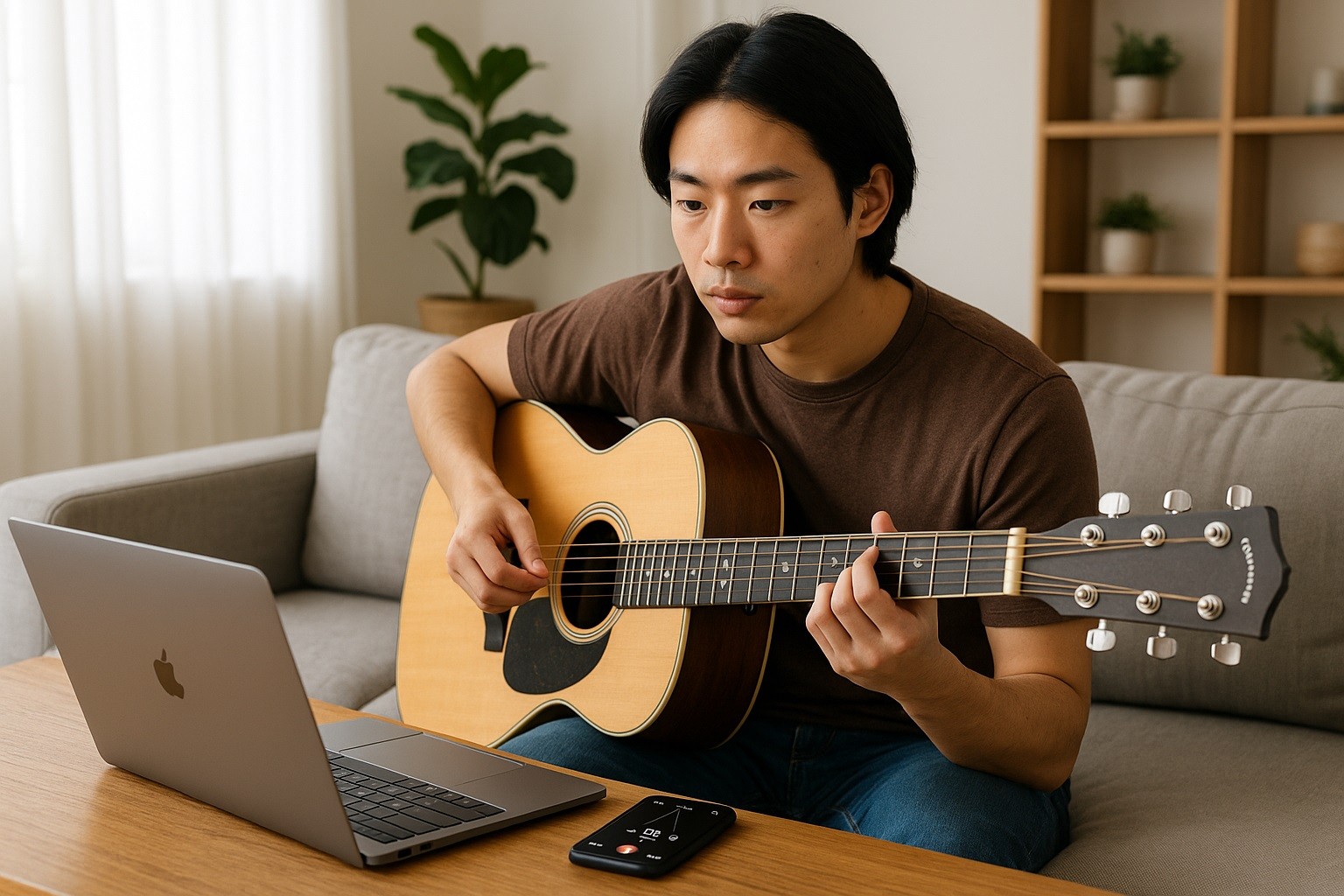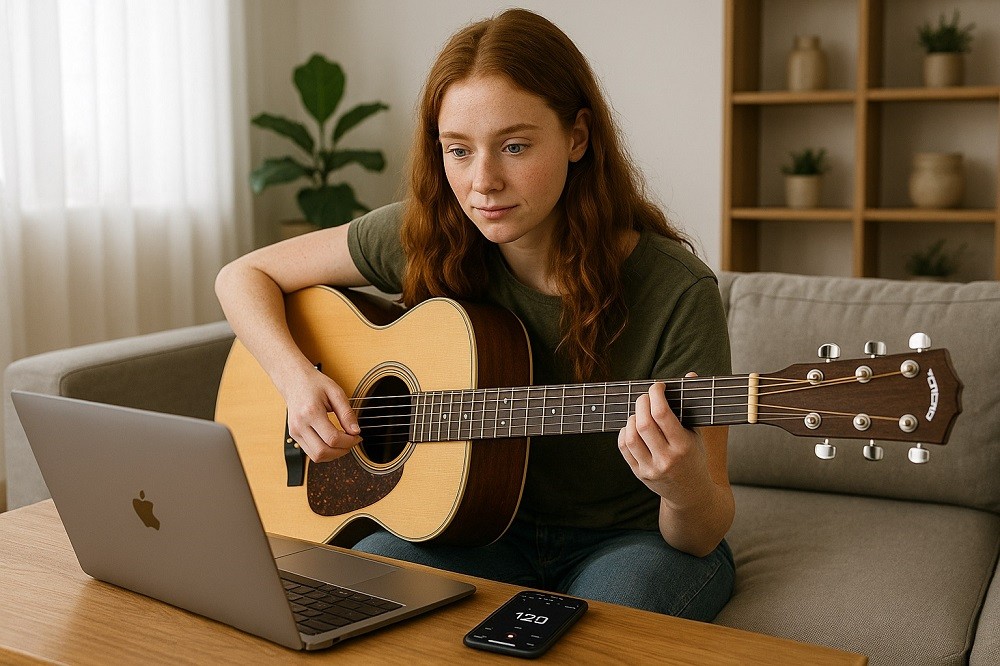Learn guitar online is practical, flexible, and effective when you follow a clear plan.
Modern courses break skills into short lessons, and free tools make structured practice simple.
With 30 focused minutes a day, you can build real progress in your first month.
What You Need to Start
You only need a playable acoustic or electric guitar, a pick, a tuner (app or clip-on), and a metronome.
A phone camera helps you record for self-feedback. If you’re unsure where to begin, start with an acoustic; it simplifies your setup while you build core skills.
You can learn to play acoustic guitar online or electric with the same foundation: chords, rhythm, songs, and basic scales.
Is it easy to learn guitar online?
It can be. Online learning removes travel time and offers self-paced lessons.
The key is structure: short daily sessions, clear goals, and steady tempo work with a metronome.
Learners who follow a progression and track small wins tend to stick with it. Think in weeks, not hours.
A Beginner Roadmap to Learn Guitar Online (first month)
Week 1: Setup + first chords
- Learn parts of the guitar, how to hold the pick, and how to tune.
- Memorize string names (E–A–D–G–B–E).
- Learn G, C, D; practice a steady down-up strum at 60–70 BPM.
Week 2: Chords + rhythm
- Add Am, Em, A, E.
- Use a metronome to improve timing; start slow and increase gradually.
- Learn your first full song using chord charts or tabs.
Week 3: Riffs + power chords
- Learn a 12-bar blues in E, basic palm muting, and power chords.
- Start reading tablature (TAB) so you can learn riffs quickly.
Week 4: Fingerstyle + first scale
- Learn the A minor pentatonic scale for simple solos.
- Try a basic fingerpicking pattern on an acoustic tune.
- Record a short performance to review posture, timing, and tone.

Can I Teach Myself How to Play the Guitar?
Yes. Many players start as self-taught using a structured free course plus a daily routine.
JustinGuitar offers a complete, graded beginner path at no cost, including practice routines and song tutorials.
If you learn best with a syllabus and due dates, you can also audit “Guitar for Beginners” from Berklee through platforms like Coursera or edX.
These options provide order and momentum when you’re practicing alone.
Can I Learn Guitar Online For Free?
Full beginner courses: JustinGuitar’s “Beginner Course” is free and comprehensive.
University-backed MOOCs (audit mode): Berklee’s beginner course on major MOOC platforms can be taken for free when you audit.
Song libraries and tabs: Ultimate Guitar offers a vast catalog of free tabs and chord sheets, providing a fast and convenient way to learn your favorite songs.
You can learn how to play the guitar on YouTube with channels like JustinGuitar, Marty Music, and Andy Guitar.
Learn How To Play The Bass Guitar Online For Free
If your goal is bass, you can follow a parallel path without paying.
StudyBass offers a leveled curriculum covering technique, rhythm, reading, and essential theory at no cost.
TalkingBass maintains a large free lesson map and videos from fundamentals to slap.
Both are designed for self-learners who want a clear progression.
Daily Practice Template (30 minutes)
Warm-up (5 min): slow chromatic or spider exercises.
Chords & rhythm (10 min): focus on two chord transitions with a metronome. Increase BPM only when clean.
Song work (10–15 min): learn one section at a time using a chord chart or tab. Loop and slow tricky parts.
Review (1–2 min): record 30 seconds. Note buzzes, timing issues, and tension. Set one goal for tomorrow.
Tip: Keep a simple practice log with today’s BPM, chords, song section, and one small target for the next session. Small, consistent wins add up quickly.
Using YouTube and Tabs Wisely
YouTube can take you from zero to real songs if you follow a progression and avoid random hopping.
Build a playlist that mirrors your roadmap: beginner technique lessons, chord changes, strumming patterns, and two or three easy song tutorials.
Pair videos with Ultimate Guitar tabs or chord sheets; they’re handy for memorizing shapes and song forms.
Because many tabs are user-submitted, prefer official versions or top-rated entries.
Tools That Accelerate Learning
If you want gamified practice, platforms like Fender Play and Yousician offer guided paths and feedback.
Many learners combine a paid app trial with free channels for songs and style exploration.
- Metronome: improves timing and control; use it daily.
- Tuner app: keeps practice consistent; retune every session.
- Loop/slowdown apps: slowing sections helps you lock in rhythm and articulation.
- Backing tracks: jam over simple grooves to apply chords or scales in context.

Motivation, Feedback, and Next Steps
Stay accountable by recording a weekly “one-take” video. Share it with a friend or an online community for feedback.
When you hit a plateau, do a “reset week”: revisit posture, fret hand angle, and right-hand motion; reduce speed; rebuild accuracy.
If you prefer live input, book a single online lesson to correct technique and set new goals, then return to your self-guided plan.
Pros, Cons and Challenges
Here’s a quick table you can use right away.
| Topic | Pros | Cons | Challenges |
|---|---|---|---|
| Cost | Many free lessons and courses; trial periods for apps. | Premium features locked behind paywalls. | Finding credible free resources without ads or upsells. |
| Convenience & Access | 24/7 learning from home; no travel. | Screen fatigue; home distractions. | Creating a quiet, dedicated practice spot. |
| Pace & Scheduling | Self-paced; you set session length. | Easy to skip days or drift. | Building a consistent daily routine. |
| Curriculum Choice | Huge range of structured paths. | Choice overload; inconsistent sequencing. | Picking one course and sticking to it for 4+ weeks. |
| Instructor Quality | Access to top teachers worldwide. | Quality varies widely online. | Vetting channels, syllabi, and sample lessons first. |
| Feedback | Apps give tempo, tuning, and timing data. | Limited real-time technique correction. | Recording yourself; booking an occasional live check-in. |
| Technique & Posture | Slow-motion demos and close-ups help. | Bad habits can go unnoticed. | Using mirrors/cameras; reviewing angles and hand position. |
| Motivation & Accountability | Streaks, trackers, and goal features. | No built-in external pressure. | Setting weekly goals; sharing progress with a friend/community. |
| Song Library | Massive tabs, play-alongs, and styles. | Inconsistent or inaccurate tabs. | Choosing official/top-rated versions; finishing full songs. |
| Recording & Analytics | Easy to log BPM, reps, and takes. | Tracking can feel tedious. | Keeping a simple one-line practice log each day. |
| Community & Collaboration | Forums, Discords, and virtual jams. | Less ensemble and stage experience. | Joining online jams; scheduling local open-mics. |
| Gear & Tech | Only a guitar, tuner, and metronome needed. | Reliance on stable internet/device. | Ensuring a solid connection; keeping backups for power/apps. |
| Style Coverage | Learn acoustic, electric, bass, and niche styles. | Some styles lack depth in free content. | Mixing a main course with targeted style channels. |
| Performance Transition | Backing tracks simulate band context. | Limited real audience feedback. | Playing for friends; posting monthly “one-take” videos. |
Final Takeaway
Your best path to learn guitar online is simple: pick one structured course, add two trusted YouTube channels, and practice 30 minutes a day with a metronome.
Use tabs to learn real songs from week one. Record yourself weekly, adjust, and keep going—you’ll see steady results in your first month.